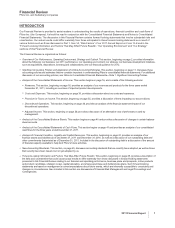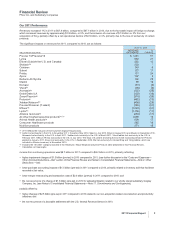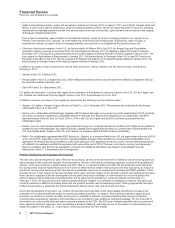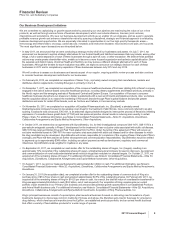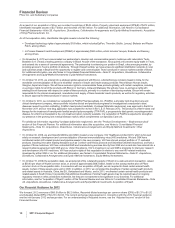Pfizer 2011 Annual Report Download - page 6
Download and view the complete annual report
Please find page 6 of the 2011 Pfizer annual report below. You can navigate through the pages in the report by either clicking on the pages listed below, or by using the keyword search tool below to find specific information within the annual report.
Financial Review
Pfizer Inc. and Subsidiary Companies
In addition:
•Individual Mandate—The financial impact of U.S. healthcare reform may be affected by certain additional developments over the next
few years, including pending implementation guidance relating to the U.S. Healthcare Legislation and certain healthcare reform
proposals. In addition, the U.S. Healthcare Legislation requires that, except in certain circumstances, individuals obtain health
insurance beginning in 2014, and it also provides for an expansion of Medicaid coverage in 2014. It is expected that, as a result of
these provisions, there will be a substantial increase in the number of Americans with health insurance beginning in 2014, a significant
portion of whom will be eligible for Medicaid. We anticipate that this will increase demand for pharmaceutical products overall. However,
because of the substantial mandatory rebates we pay under the Medicaid program, we do not anticipate that implementation of the
coverage expansion will generate significant additional revenues for Pfizer. The individual mandate is currently the subject of a legal
challenge before the U.S. Supreme Court. If the Supreme Court strikes down the mandate, but allows the other provisions of the U.S.
Healthcare Legislation to remain in force, the benefits of the U.S. Healthcare Legislation to Pfizer will diminish. However, we do not
expect the impact on us of any such decision to be material because we anticipate that many Americans will choose coverage even in
the absence of a mandate as a result of the government subsidies that will make purchasing coverage more affordable.
•Biotechnology Products—The U.S. Healthcare Legislation provides an abbreviated legal pathway to approve biosimilars (also referred
to as “follow-on biologics”). Innovator biologics were granted 12 years of exclusivity, with a potential six-month pediatric extension. After
the exclusivity period expires, the U.S. Food and Drug Administration (FDA) could approve biosimilar versions of innovator biologics.
The regulatory implementation of these provisions is ongoing and expected to take several years. However, the FDA has begun to
clarify its expectations for approval via the biosimilar pathway with the recent issuance of three draft guidance documents. Among other
things, these draft guidance documents confirm that the FDA will allow biosimilar applicants to use a non-U.S. licensed comparator in
certain studies to support a demonstration of biosimilarity to a U.S.-licensed reference product. If competitors are able to obtain
marketing approval for biosimilars referencing our biotechnology products, our biotechnology products may become subject to
competition from biosimilars, with the attendant competitive pressures. Concomitantly, a better-defined biosimilars approval pathway
will assist us in pursuing approval of our own biosimilar products in the U.S.
The budget proposal submitted to Congress by President Obama in February 2012 includes a provision that would reduce the
base exclusivity period for a biologics product from 12 years to seven years. There is no corresponding pending bill designed to
amend the U.S. Healthcare Legislation to alter the biologics provisions.
The Loss or Expiration of Intellectual Property Rights
As is inherent in the biopharmaceutical industry, the loss or expiration of intellectual property rights can have a significant adverse
effect on our revenues. Many of our products have multiple patents that expire at varying dates, thereby strengthening our overall
patent protection. However, once patent protection has expired or has been lost prior to the expiration date as a result of a legal
challenge, we lose exclusivity on these products, and generic pharmaceutical manufacturers generally produce similar products and
sell them for a lower price. This price competition can substantially decrease our revenues for products that lose exclusivity, often in
a very short period of time. While small molecule products are impacted in such a manner, biologics currently have additional
barriers to entry related to the manufacture of such products and, unlike small molecule generics, biosimilars are not necessarily
identical to the reference products. Therefore, generic competition with respect to biologics may not be as significant. A number of
our current products are expected to face significantly increased generic competition over the next few years.
Our financial guidance for 2012 reflects the anticipated impact of the loss of exclusivity of various products and the expiration of
certain alliance product contract rights discussed below (see the “Our Financial Guidance for 2012” section of this Financial
Review). Specifically:
•Lipitor overview—In 2011, worldwide revenues from Lipitor were approximately $9.6 billion, or approximately 14% of total Pfizer
revenues. Of this amount, approximately $5.0 billion was generated in the U.S. and approximately $4.6 billion was generated in
international markets, including approximately $859 million in emerging markets. We expect that the losses of exclusivity for Lipitor in
the U.S. and various international markets discussed below will have a significant adverse impact on our revenues in 2012 and
subsequent years.
•Lipitor in the U.S.—In November 2011, we lost exclusivity in the U.S. for Lipitor.
Pfizer announced in June 2008 that we entered into an agreement providing a license to Ranbaxy to sell generic versions of
Lipitor and Caduet in the U.S effective November 30, 2011. In addition, the agreement provides a license for Ranbaxy to sell a
generic version of Lipitor beginning on varying dates in several additional countries. (See Notes to Consolidated Financial
Statements—Note 17. Commitments and Contingencies for a discussion of certain litigation relating to this agreement.) We also
granted Watson Pharmaceuticals, Inc. (Watson) the exclusive right to sell the authorized generic version of Lipitor in the U.S. for a
period of five years, which commenced on November 30, 2011. As Watson’s exclusive supplier, we manufacture and sell generic
atorvastatin tablets to Watson. We expect the entry of multi-source generic competition in the U.S., with attendant increased
competitive pressures, following the end of Ranbaxy’s 180-day generic exclusivity period in late May 2012.
Through the end of 2011, sales of Lipitor in the U.S. were reported in our Primary Care business unit. Beginning in 2012, sales of
Lipitor in the U.S. will be reported in our Established Products business unit.
2011 Financial Report 5


